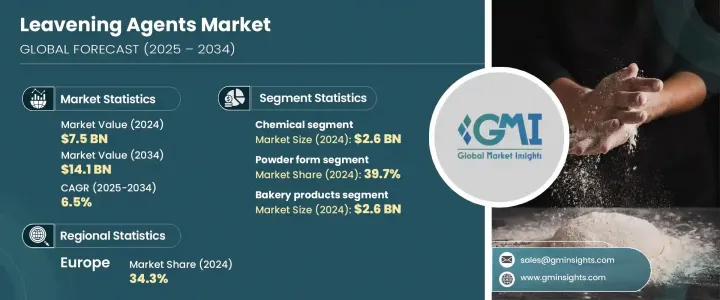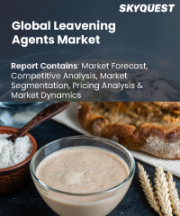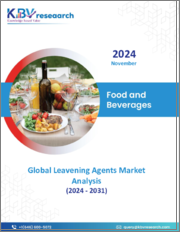
|
시장보고서
상품코드
1782098
세계의 팽창제 시장 기회, 성장 촉진요인, 산업 동향 분석, 예측(2025-2034년)Leavening Agents Market Opportunity, Growth Drivers, Industry Trend Analysis, and Forecast 2025 - 2034 |
||||||
세계의 팽창제 시장 규모는 2024년에 75억 달러로 평가되었고, CAGR 6.5%를 나타내 2034년에는 141억 달러에 이를 것으로 예상되고 있습니다.
이 분야의 성장은 식생활의 변화나 도시 인구의 확대와 함께 베이커리, 스낵, 조리된 식품의 각 분야에서 수요가 높아지고 있는 것이 배경에 있습니다. 오늘날의 소비자들은 식감 개선, 보존 기간 연장, 깨끗한 성분표를 제공하는 제품에 기울고 있습니다. 천연 소재와 유기농 소재로의 변화도 기세를 늘리고 있으며, 발효 기반의 약은 건강에 좋은 매력으로 지보를 굳히고 있습니다. 클린 라벨 처방과 식물 유래 대체품의 혁신은 시장이 어떻게 진화하는지에 매우 중요한 역할을 합니다. 한편 브랜드는 지속 가능한 생산에 점점 더 중점을 두고 있으며, 제품의 성능을 높이고 가공 시간을 단축하는 한편 환경 풋 프린트를 줄이는 방법을 모색하고 있습니다.

특히 신흥국 시장에서 식품제조기술의 개발이 새로운 가능성을 열고 있습니다. 특히 영양과 지속가능성에 대한 소비자들의 기대가 높아짐에 따라 팽창제 전망을 재구성하고 있습니다. 각 회사는 R&D에 투자하고 에너지 소비를 줄이고 건강한 제품을 생산하는 솔루션을 창출하고 있습니다. 수요는 계속 천연 소재, 최소한의 가공 밖에 베풀어지지 않은 소재에 기울어져, 베이킹 소다, 분말, 발효법에 의한 생물학적 전분에의 꾸준한 변화를 촉진하고 있습니다.
| 시장 범위 | |
|---|---|
| 시작 연도 | 2024년 |
| 예측 연도 | 2025-2034년 |
| 시작 금액 | 75억 달러 |
| 예측 금액 | 141억 달러 |
| CAGR | 6.5% |
2024년에는 화학팽창제 분야가 26억 달러의 평가액으로 34.8%의 점유율을 차지했습니다. 안정적인 성능으로 제빵 분야에서 널리 사용되고 있음에도 불구하고 산과 중탄산염과 같은 화학 전분은 건강 지향 구매자의 반감을 사고 있습니다. 이 때문에 아밀라아제나 프로테아제 등 환경친화적인 효소와 같은 생물학적 대체품에 길을 열어 여러 용도로 서서히 지지를 모으고 있습니다.
분말 팽창제 분야는 2024년에 39.7%의 점유율을 차지했고, 2034년까지의 CAGR은 6.3%를 나타낼 것으로 예상됩니다. 이 형식은 범용성, 보존 안정성 및 식품 제조 워크플로우에 원활하게 통합되어 여전히 선호되고 있습니다. 사용의 용이성, 측정의 정확성, 즉각적인 용해성으로 인해 분말은 특히 구운 과자와 가공 식품의 범주에 적합하며 대규모 생산과 장인 생산 모두의 설정에서 매력을 확고하게 만듭니다.
2024년 유럽의 팽창제 시장 점유율은 34.3%를 나타냈는데, 건강, 글루텐 프리 및 장인 구운 과자에 대한 수요 증가로 인한 것입니다. 이 지역은 편의점의 소비 증가와 소비자 건강 지향의 진화로 인해 강력한 기세가 계속되고 있습니다. 도시화와 라이프스타일 변화도 특히 신흥 시장 성장에 박차를 가하고 있습니다. 이 지역은 깨끗한 라벨과 지속 가능한 원재료의 동향을 받아들이고 있기 때문에 세계 시장의 수익 전망의 열쇠를 쥐고있는 존재입니다.
이 업계를 형성하는 주목할만한 기업으로는 DuPont, Ralemand, Rezaffle Group, Kelly Group plc, Cargil Incorporated 등이 있습니다. 시장에서의 지위를 강화하기 위해 주요 기업은 제품 혁신, 세계 전개 및 지속 가능한 조달을 중심으로 한 전략을 채택하고 있습니다. 각 회사는 깨끗한 라벨과 알레르겐 프리 요구 사항을 충족하는 고급 배합을 개발하는 반면 비용 효율성을 높이기 위해 생산을 간소화합니다. 합병과 파트너십은 특히 신흥 경제 국가에서 미개척 시장에 진입하는 데 도움이 됩니다. 동시에 기업은 친환경 사업 운영과 공급망 물류의 디지털 변혁에 투자하여 브랜드의 신뢰성을 높이고 소비자의 기대가 진화하면서 경쟁력을 유지하고 있습니다.
목차
제1장 조사 방법과 범위
제2장 주요 요약
제3장 업계 인사이트
- 생태계 분석
- 공급자의 상황
- 이익률
- 각 단계에서의 부가가치
- 밸류체인에 영향을 주는 요인
- 파괴적 혁신
- 업계에 미치는 영향요인
- 성장 촉진요인
- 업계의 잠재적 위험 및 과제
- 시장 기회
- 성장 가능성 분석
- 규제 상황
- 북미
- 유럽
- 아시아태평양
- 라틴아메리카
- 중동 및 아프리카
- Porter's Five Forces 분석
- PESTEL 분석
- 가격 동향
- 지역별
- 제품별
- 향후 시장 동향
- 기술과 혁신의 상황
- 현재 기술 동향
- 신흥기술
- 특허 상황
- 무역 통계(HS코드)(참고 : 무역 통계는 주요 국가에서만 제공됨)
- 주요 수입국
- 주요 수출국
- 지속가능성과 환경 측면
- 지속가능한 관행
- 폐기물 감축 전략
- 생산에 있어서의 에너지 효율
- 환경 친화적인 노력
제4장 경쟁 구도
- 서론
- 기업의 시장 점유율 분석
- 지역별
- 북미
- 유럽
- 아시아태평양
- 라틴아메리카
- 중동 및 아프리카
- 지역별
- 기업 매트릭스 분석
- 주요 시장 기업의 경쟁 분석
- 경쟁 포지셔닝 매트릭스
- 주요 발전
- 합병과 인수
- 파트너십 및 협업
- 신제품 발매
- 확장 계획
제5장 시장 추계·예측 : 효소 유형별(2021-2034년)
- 주요 동향
- 화학 팽창제
- 베이킹 파우더
- 베이킹 소다(탄산수소나트륨)
- 타르타르 크림
- 모노칼슘 인산염
- 나트륨산 피로 인산염
- 인산알루미늄나트륨
- 중탄산암모늄
- 칼슘 산 피로 인산염
- 생물팽창제
- 빵 효모
- 사워 도우 스타터
- 야생 효모
- 특수효모제품
- 물리적 팽창제
- 신흥 및 대체 팽창제
제6장 시장 추계·예측 : 형태별(2021-2034년)
- 주요 동향
- 분말 형태
- 미세 분말
- 과립 분말
- 캡슐화 분말
- 액체 형태
- 농축 액체
- 즉시 사용 가능한 액체
- 정제/압축 형태
- 페이스트 형태
제7장 시장 추계·예측 : 용도별(2021-2034년)
- 주요 동향
- 베이커리 제품
- 빵 및 롤
- 케이크 및 페이스트리
- 쿠키 및 비스킷
- 머핀 및 컵케이크
- 피자 반죽
- 도넛 및 과자류
- 제과 제품
- 초콜릿 제품
- 설탕 과자
- 껌 및 사탕
- 가공식품
- 바로 먹을 수 있는 식사
- 스낵 식품
- 냉동 식품
- 특수 용도
- 글루텐 프리 제품
- 유기농 제품
- 기능성 식품
- 단백질 강화 제품
제8장 시장 추계·예측 : 지역별(2021-2034년)
- 주요 동향
- 북미
- 미국
- 캐나다
- 유럽
- 독일
- 영국
- 프랑스
- 스페인
- 이탈리아
- 네덜란드
- 기타 유럽
- 아시아태평양
- 중국
- 인도
- 일본
- 호주
- 한국
- 기타 아시아태평양
- 라틴아메리카
- 브라질
- 멕시코
- 아르헨티나
- 기타 라틴아메리카
- 중동 및 아프리카
- 사우디아라비아
- 남아프리카
- 아랍에미리트(UAE)
- 기타 중동 및 아프리카
제9장 기업 프로파일
- Lesaffre Group
- Angel Yeast Co., Ltd.
- Lallemand Inc.
- AB Mauri(Associated British Foods)
- Kerry Group plc
- Cargill, Incorporated
- DuPont de Nemours, Inc.
- Innophos Holdings, Inc.
- Solvay SA
- ICL Food Specialties
- Corbion NV
- Puratos Group
- DSM-Firmenich
- Archer Daniels Midland Company(ADM)
- Church &Dwight Co., Inc.
- Clabber Girl Corporation
- Wright Group
- Kudos Blends Limited
- Vitusa Products, Inc.
- Asmussen GmbH
The Global Leavening Agents Market was valued at USD 7.5 billion in 2024 and is estimated to grow at a CAGR of 6.5% to reach USD 14.1 billion by 2034. Growth in this space is being fueled by rising demand across the bakery, snack, and ready-to-eat food segments, coupled with changing dietary habits and expanding urban populations. Consumers today are leaning into products that offer improved texture, longer shelf life, and clean ingredient lists. The shift toward natural and organic ingredients is also gaining momentum, with fermentation-based agents gaining ground thanks to their health-friendly appeal. Innovations in clean-label formulations and plant-based alternatives are playing a pivotal role in how the market evolves. Meanwhile, brands are increasingly focused on sustainable production, seeking ways to reduce their environmental footprint while enhancing product performance and reducing processing times.

Developments in food manufacturing technology, especially in emerging markets, are opening new possibilities. Evolving consumer expectations, particularly around nutrition and sustainability, are reshaping the leavening agent landscape. Companies are investing in R&D to create solutions that support lower energy consumption and healthier outputs. Demand continues to tilt toward natural, minimally processed inputs, prompting a steady shift toward baking soda, powders, and biological leaveners driven by fermentation methods.
| Market Scope | |
|---|---|
| Start Year | 2024 |
| Forecast Year | 2025-2034 |
| Start Value | $7.5 Billion |
| Forecast Value | $14.1 Billion |
| CAGR | 6.5% |
In 2024, the chemical leavening agents segment held a 34.8% share with a valuation of USD 2.6 billion. Despite their widespread use in baking due to consistent performance, chemical leaveners such as acids and bicarbonates are seeing pushback from health-conscious buyers. This has paved the way for biological alternatives like eco-friendly enzymes, including amylases and proteases, which are gradually gaining traction across multiple applications.
The powdered leavening agents segment held a 39.7% share in 2024 and is expected to grow at a CAGR of 6.3% through 2034. This format remains a favorite for its versatility, shelf stability, and seamless integration into food production workflows. The ease of use, accuracy in measurement, and instant solubility make powders especially suitable for baked and processed food categories, solidifying their appeal across both large-scale and artisanal production setups.
Europe Leavening Agents Market held a 34.3% share in 2024, owing to the rising demand for healthy, gluten-free, and artisanal baked goods. The region continues to experience strong momentum due to increased consumption of convenience foods and evolving consumer health priorities. Urbanization and lifestyle changes are also spurring growth, especially in emerging markets. The region remains key to the global market's revenue outlook as it embraces clean-label and sustainable ingredient trends.
Notable players shaping this industry include DuPont de Nemours, Inc., Lallemand Inc., Lesaffre Group, Kerry Group plc, and Cargill Incorporated. To strengthen their market position, leading companies are adopting strategies centered on product innovation, global expansion, and sustainable sourcing. They are developing advanced formulations to meet clean-label and allergen-free requirements, while also streamlining production to improve cost efficiency. Mergers and partnerships are helping them reach untapped markets, especially in developing economies. At the same time, companies are investing in environmentally responsible operations and digital transformation in supply chain logistics, reinforcing brand credibility and staying competitive amid evolving consumer expectations.
Table of Contents
Chapter 1 Methodology & Scope
- 1.1 Market scope and definition
- 1.2 Research design
- 1.2.1 Research approach
- 1.2.2 Data collection methods
- 1.3 Data mining sources
- 1.3.1 Global
- 1.3.2 Regional/Country
- 1.4 Base estimates and calculations
- 1.4.1 Base year calculation
- 1.4.2 Key trends for market estimation
- 1.5 Primary research and validation
- 1.5.1 Primary sources
- 1.6 Forecast model
- 1.7 Research assumptions and limitations
Chapter 2 Executive Summary
- 2.1 Industry 3600 synopsis
- 2.2 Key market trends
- 2.2.1 Regional
- 2.2.2 Product
- 2.2.3 Form
- 2.2.4 Application
- 2.3 TAM Analysis, 2025-2034
- 2.4 CXO perspectives: Strategic imperatives
- 2.4.1 Executive decision points
- 2.4.2 Critical success factors
- 2.5 Future outlook and strategic recommendations
Chapter 3 Industry Insights
- 3.1 Industry ecosystem analysis
- 3.1.1 Supplier landscape
- 3.1.2 Profit margin
- 3.1.3 Value addition at each stage
- 3.1.4 Factor affecting the value chain
- 3.1.5 Disruptions
- 3.2 Industry impact forces
- 3.2.1 Growth drivers
- 3.2.2 Industry pitfalls and challenges
- 3.2.3 Market opportunities
- 3.3 Growth potential analysis
- 3.4 Regulatory landscape
- 3.4.1 North America
- 3.4.2 Europe
- 3.4.3 Asia Pacific
- 3.4.4 Latin America
- 3.4.5 Middle East & Africa
- 3.5 Porter’s analysis
- 3.6 PESTEL analysis
- 3.6.1 Technology and innovation landscape
- 3.6.2 Current technological trends
- 3.6.3 Emerging technologies
- 3.7 Price trends
- 3.7.1 By region
- 3.7.2 By product
- 3.8 Future market trends
- 3.9 Technology and innovation landscape
- 3.9.1 Current technological trends
- 3.9.2 Emerging technologies
- 3.10 Patent landscape
- 3.11 Trade statistics (HS code) (Note: the trade statistics will be provided for key countries only)
- 3.11.1 Major importing countries
- 3.11.2 Major exporting countries
- 3.12 Sustainability and environmental aspects
- 3.12.1 Sustainable practices
- 3.12.2 Waste reduction strategies
- 3.12.3 Energy efficiency in production
- 3.12.4 Eco-friendly initiatives
Chapter 4 Competitive Landscape, 2024
- 4.1 Introduction
- 4.2 Company market share analysis
- 4.2.1 By region
- 4.2.1.1 North America
- 4.2.1.2 Europe
- 4.2.1.3 Asia Pacific
- 4.2.1.4 LATAM
- 4.2.1.5 MEA
- 4.2.1 By region
- 4.3 Company matrix analysis
- 4.4 Competitive analysis of major market players
- 4.5 Competitive positioning matrix
- 4.6 Key developments
- 4.6.1 Mergers & acquisitions
- 4.6.2 Partnerships & collaborations
- 4.6.3 New product launches
- 4.6.4 Expansion plans
Chapter 5 Market Estimates and Forecast, By Enzyme Type, 2021 - 2034 (USD Billion) (Kilo Tons)
- 5.1 Key trends
- 5.2 Chemical leavening agents
- 5.2.1 Baking powder
- 5.2.2 Baking soda (Sodium Bicarbonate)
- 5.2.3 Cream of tartar
- 5.2.4 Monocalcium phosphate
- 5.2.5 Sodium acid pyrophosphate
- 5.2.6 Sodium aluminum phosphate
- 5.2.7 Ammonium bicarbonate
- 5.2.8 Calcium acid pyrophosphate
- 5.3 Biological leavening agents
- 5.3.1 Baker's yeast
- 5.3.2 Sourdough starter
- 5.3.3 Wild yeast
- 5.3.4 Specialty yeast products
- 5.4 Physical leavening agents
- 5.5 Emerging and alternative leavening agents
Chapter 6 Market Estimates and Forecast, By Form, 2021 - 2034 (USD Billion) (Kilo Tons)
- 6.1 Key trends
- 6.2 Powder form
- 6.2.1 Fine powder
- 6.2.2 Granulated powder
- 6.2.3 Encapsulated powder
- 6.3 Liquid form
- 6.3.1 Concentrated liquid
- 6.3.2 Ready-to-use liquid
- 6.4 Tablet/Compressed form
- 6.5 Paste form
Chapter 7 Market Estimates and Forecast, By Application, 2021 - 2034 (USD Billion) (Kilo Tons)
- 7.1 Key trends
- 7.2 Bakery products
- 7.2.1 Bread and rolls
- 7.2.2 Cakes and pastries
- 7.2.3 Cookies and biscuits
- 7.2.4 Muffins and cupcakes
- 7.2.5 Pizza dough
- 7.2.6 Donuts and sweet goods
- 7.3 Confectionery products
- 7.3.1 Chocolate products
- 7.3.2 Sugar confectionery
- 7.3.3 Gum and candies
- 7.4 Processed foods
- 7.4.1 Ready-to-eat meals
- 7.4.2 Snack foods
- 7.4.3 Frozen foods
- 7.5 Specialty applications
- 7.5.1 Gluten-free products
- 7.5.2 Organic products
- 7.5.3 Functional foods
- 7.5.4 Protein-enriched products
Chapter 8 Market Estimates and Forecast, By Region, 2021 - 2034 (USD Billion) (Kilo Tons)
- 8.1 Key trends
- 8.2 North America
- 8.2.1 U.S.
- 8.2.2 Canada
- 8.3 Europe
- 8.3.1 Germany
- 8.3.2 UK
- 8.3.3 France
- 8.3.4 Spain
- 8.3.5 Italy
- 8.3.6 Netherlands
- 8.3.7 Rest of Europe
- 8.4 Asia Pacific
- 8.4.1 China
- 8.4.2 India
- 8.4.3 Japan
- 8.4.4 Australia
- 8.4.5 South Korea
- 8.4.6 Rest of Asia Pacific
- 8.5 Latin America
- 8.5.1 Brazil
- 8.5.2 Mexico
- 8.5.3 Argentina
- 8.5.4 Rest of Latin America
- 8.6 Middle East and Africa
- 8.6.1 Saudi Arabia
- 8.6.2 South Africa
- 8.6.3 UAE
- 8.6.4 Rest of Middle East and Africa
Chapter 9 Company Profiles
- 9.1 Lesaffre Group
- 9.2 Angel Yeast Co., Ltd.
- 9.3 Lallemand Inc.
- 9.4 AB Mauri (Associated British Foods)
- 9.5 Kerry Group plc
- 9.6 Cargill, Incorporated
- 9.7 DuPont de Nemours, Inc.
- 9.8 Innophos Holdings, Inc.
- 9.9 Solvay S.A.
- 9.10 ICL Food Specialties
- 9.11 Corbion N.V.
- 9.12 Puratos Group
- 9.13 DSM-Firmenich
- 9.14 Archer Daniels Midland Company (ADM)
- 9.15 Church & Dwight Co., Inc.
- 9.16 Clabber Girl Corporation
- 9.17 Wright Group
- 9.18 Kudos Blends Limited
- 9.19 Vitusa Products, Inc.
- 9.20 Asmussen GmbH















